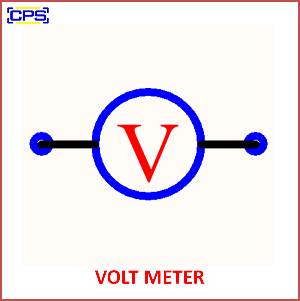A Voltmeter is an electrical instrument used to measure the voltage, or potential difference, between two points in an electrical circuit. It is typically connected across two points in the circuit to measure the potential difference without significantly altering the current flow in the circuit. Voltmeters are essential tools in diagnosing electrical systems, ensuring components function properly, and checking the power supply or circuit performance.

Key Features of a Voltmeter:
- Measurement of Voltage:
- A voltmeter measures the potential difference (voltage) between two points in a circuit, and its units are volts (V).
- High Input Impedance:
- Voltmeters are designed to have a very high input impedance to minimize the current drawn from the circuit, ensuring that they do not significantly affect the circuit they are measuring.
- Analog or Digital:
- Analog Voltmeters: Use a moving coil meter to display the voltage on a scale.
- Digital Voltmeters: Display the voltage reading as a numerical value on an LCD or LED display.
- Measurement Ranges:
- Voltmeters often come with selectable ranges for measuring different magnitudes of voltage (e.g., millivolts, volts, kilovolts).
Working Principle:
- A voltmeter is connected in parallel with the component or section of the circuit where the voltage needs to be measured. It works by comparing the electric potential difference between two points and displaying the result.
- The internal resistance of the voltmeter is very high, ensuring that it draws very little current from the circuit. This prevents the voltmeter from altering the circuit’s behavior while measuring the voltage.
Applications of a Voltmeter:
- Circuit Diagnostics:
- Used to check voltage levels in a circuit, ensuring that components receive the correct voltage.
- Power Supply Testing:
- Employed in testing power supplies and batteries to verify that the output voltage matches the expected value.
- Troubleshooting Electrical Equipment:
- Used to detect problems in electrical devices and components by measuring voltage at various points in the system.
- Monitoring Voltages in Electronics:
- Voltmeters are widely used in the development and maintenance of electronic systems, from simple devices to complex circuits.
Advantages:
- Non-Intrusive Measurement: Because voltmeters have high input impedance, they don’t draw much current, ensuring accurate measurements without affecting the circuit.
- Versatile: Can be used to measure AC or DC voltage depending on the type of voltmeter.
- Wide Range of Applications: Useful in many areas, including electronics, electrical engineering, automotive, and home appliance testing.
Disadvantages:
- Accuracy Issues: The accuracy of the measurement can be affected by the quality of the voltmeter and the precision of its scale.
- Limited Voltage Range: Some voltmeters may only measure within a limited voltage range, requiring a different type of voltmeter for higher or lower voltage levels.
